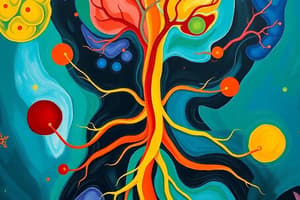Podcast
Questions and Answers
What is the primary role of the brain in maintaining homeostasis?
What is the primary role of the brain in maintaining homeostasis?
- It stores memories about past experiences to adapt to future changes.
- It receives sensory input and sends out motor output to maintain balance.
- It directly controls all the body's functions.
- It serves as the control center for processing and integrating information about internal and external environments. (correct)
Which component of the nervous system is responsible for voluntary muscle movements?
Which component of the nervous system is responsible for voluntary muscle movements?
- Sympathetic Nervous System
- Autonomic Nervous System
- Parasympathetic Nervous System
- Somatic Nervous System (correct)
What is the correct sequence of events in a negative feedback loop for regulating body temperature?
What is the correct sequence of events in a negative feedback loop for regulating body temperature?
- Sensor, Stimulus, Control Center, Effector
- Effector, Control Center, Sensor, Stimulus
- Stimulus, Sensor, Control Center, Effector (correct)
- Stimulus, Effector, Control Center, Sensor
Identify the role of the Cerebellum in the Nervous System.
Identify the role of the Cerebellum in the Nervous System.
What is the primary function of the Autonomic Nervous System (ANS)?
What is the primary function of the Autonomic Nervous System (ANS)?
During a stressful situation, which branch of the Autonomic Nervous System becomes most active?
During a stressful situation, which branch of the Autonomic Nervous System becomes most active?
Which of the following is NOT an example of a feedback mechanism?
Which of the following is NOT an example of a feedback mechanism?
Which part of the brain is responsible for processing information related to sensory input, such as touch, taste, and vision?
Which part of the brain is responsible for processing information related to sensory input, such as touch, taste, and vision?
Flashcards
Homeostasis
Homeostasis
The body’s ability to maintain a stable internal environment despite external changes.
Negative Feedback
Negative Feedback
A mechanism that counteracts changes to return the body to its normal state.
Positive Feedback
Positive Feedback
A mechanism that amplifies changes to achieve a specific outcome.
Brain
Brain
Signup and view all the flashcards
Cerebrum
Cerebrum
Signup and view all the flashcards
Autonomous Nervous System (ANS)
Autonomous Nervous System (ANS)
Signup and view all the flashcards
Sympathetic Nervous System
Sympathetic Nervous System
Signup and view all the flashcards
Homeostasis in Temperature Regulation
Homeostasis in Temperature Regulation
Signup and view all the flashcards
Study Notes
Homeostasis
- Homeostasis is the body's ability to maintain a stable internal environment despite external changes.
- Examples include body temperature, blood glucose levels, and blood pressure.
Feedback Mechanisms
- Negative Feedback: Counteracts changes to return the body to its normal state.
- Example: Body temperature regulation
- Positive Feedback: Amplifies changes to achieve a specific outcome.
- Example: Blood clotting during injury
The Brain
- The brain is a supercomputer responsible for all body functions.
- It controls thoughts, memory, emotions, motor skills, sensory processing, and much more.
- It manages voluntary actions, such as strutting and hugging, and involuntary actions, such as breathing and heartbeat.
Central Nervous System (CNS)
- The CNS is the control center.
- It processes information received from the body and sends instructions back.
- The brain controls higher-level functions.
- The spinal cord relays signals between the brain and the rest of the body, managing reflexes.
Parts of the Brain
- Cerebrum: Responsible for voluntary actions, sensory processing, learning, and memory.
- Cerebellum: Coordinates balance and movement.
- Brainstem: Regulates involuntary functions like breathing and heart rate.
Peripheral Nervous System (PNS)
- The PNS connects the CNS to the rest of the body.
- Somatic Nervous System (SNS): Controls voluntary muscle movements and sensory input.
- Autonomic Nervous System (ANS): Manages involuntary functions.
Subdivisions of the Autonomic Nervous System (ANS)
- Sympathetic Nervous System: Activates the "fight or flight" response during stress.
- Parasympathetic Nervous System: Promotes the "rest and digest" state during relaxation.
Roles of the Nervous System
- Sensory Input: Detects changes in the environment (stimuli).
- Processing Center: The brain and spinal cord interpret and process information.
- Motor Output: Sends signals to effectors (muscles or glands) to correct any imbalances.
Body Temperature Regulation
- Stimulus: Changes in body temperature.
- Sensor: Skin and hypothalamus detect the change.
- Control Center: Hypothalamus processes the signal.
- Effector: Sweat glands, blood vessels, and muscles correct the temperature.
Blood Glucose Regulation
- Stimulus: Changes in blood glucose levels.
- Sensor & Control Center: Pancreas working with the nervous system.
- Effector: Liver and muscle cells regulate glucose levels.
Blood Pressure Regulation
- Stimulus: Changes in blood pressure.
- Sensor: Baroreceptors in blood vessels detect changes.
- Control Center: Medulla oblongata.
- Effector: Heart rate and blood vessel diameter adjust to maintain or restore normal levels.
Importance of Homeostasis
- The nervous system ensures survival and rapid response to internal and external changes.
- Understanding homeostasis highlights the remarkable complexity and efficiency of the body.
Quick Activity
- This section may include a scenario-based activity requiring students to identify stimuli, sensors, control centers, and effectors involved in a given situation.
Studying That Suits You
Use AI to generate personalized quizzes and flashcards to suit your learning preferences.




